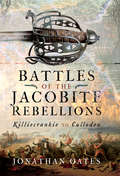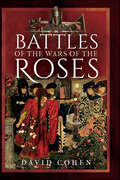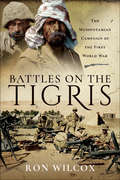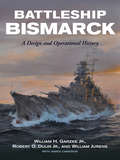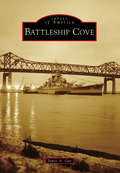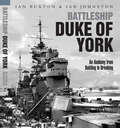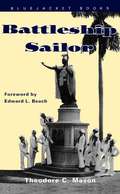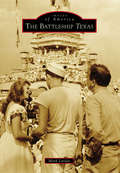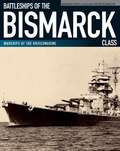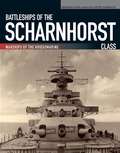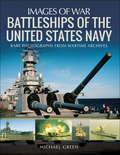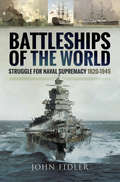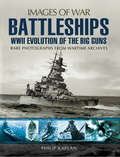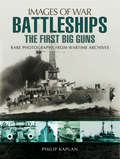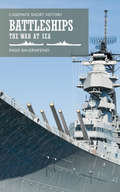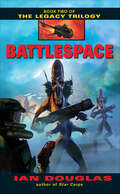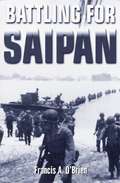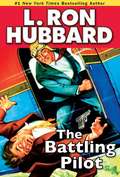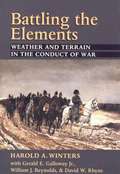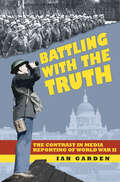- Table View
- List View
Battles of the Jacobite Rebellions: Killiecrankie to Culloden
by Jonathan Oates“Oates examines in minute detail why the Jacobite forces posed such a threat to William and Mary, Queen Anne, and George I and II.” —Books MonthlyMany books have been written about the Jacobite rebellions—the armed attempts made by the Stuarts to regain the British throne between 1689 and 1746—and in particular about the risings of 1689, 1715, 1719 and 1745. The key battles have been described in graphic detail. Yet no previous book has given a comprehensive military account of the campaigns in their entirety—and that is the purpose of Jonathan Oates’s new history.For over fifty years the Jacobites posed a serious threat to the governments of William and Mary, Queen Anne and George I and II. But they were unable to follow up their victories at Killiecrankie, Prestonpans and Falkirk, and the overwhelming defeat suffered by Bonnie Prince Charlie’s army when it confronted the Duke of Cumberland’s forces at Culloden in 1746 was decisive.The author uses vivid eyewitness testimony and contemporary sources, as well as the latest archaeological evidence, to trace the course of the conflict, and offers an absorbing insight into the makeup of the opposing sides, their leadership, their troops and the strategy and tactics they employed. His distinctive approach gives the reader a long perspective on a conflict which is often viewed more narrowly in terms of famous episodes and the careers of the leading men.“A novel and rewarding approach in providing a comprehensive account of the Jacobite rebellions. This is a story of a family torn apart by religion and entitlement. Highly Recommended.” —Firetrench
Battles of the Revolutionary War, 1775–1781: 1775-1781 (Major Battles and Campaigns)
by William J. Wood John D. EisenhowerA military historian’s “eminently readable” look at the strategy and tactics at Bunker Hill, Trenton, and other battles of the American Revolution (George F. Scheer, author of Rebels and Redcoats). This groundbreaking study argues that the Americans did not simply outlast the British in the Revolutionary War—but won their independence by employing superior strategies, tactics, and leadership. For history buffs and armchair strategists, here is a blow-by-blow analysis of the men, commanders, and weaponry used in the famous battles of Bunker Hill, Quebec, Trenton, Princeton, Saratoga, Cowpens, and more—with dozens of detailed maps and illustrations.
Battles of the Wars of the Roses
by David CohenThe Wars of the Roses saw a series of bloody battles during one of the most turbulent periods of English history. The houses of Lancaster and York fought for control of the crown, devastating the nobility and bringing an end to the illustrious Plantagenet dynasty. Starting with an overview of the politics and events that culminated in the wars, this new history focuses on the seventeen battles that took place around the country between 1455 and 1487. It considers the causes, course and result of each battle, beginning with the first battle of St Albans on 22 May 1455, which was won by the Yorkist faction lead by Richard, Duke of York. The bloodiest battle ever known on English soil at Towton on 29 March 1461, and the victory there of the first Yorkist King Edward IV is described here in vivid detail. The battle of Tewkesbury on 4 May 1471 saw the death of Edward Prince of Wales, the last male heir of the Lancastrians, and the subsequent murder of King Henry VI at the Tower of London. The defeat and death of King Richard III at the battle of Bosworth on 22 August 1485 marked the end of the Plantagenet dynasty. The last battle of the Wars of the Roses was at East Stoke on 16 June 1487 where the first Tudor King Henry VII crushed the Yorkist revolt. The final chapter of the book is devoted to the mystery of the Princes in the Tower, who disappeared at the Tower of London during the reign of King Richard III in 1483, and the suspects to their likely murders. Written with the most up-to-date archaeological and documentary research, and including many images of the main protagonists, battle sites, maps and genealogical charts, this is a fascinating new insight into the Wars of the Roses.
Battles on the Tigris: The Mesopotamian Campaign of the First World War
by Ron WilcoxIn 1914 the British expedition to Mesopotamia set out with the modest ambition of protecting the oil concession in Southern Persia but, after numerous misfortunes, ended up capturing Baghdad and Northern Towns in Iraq. Initially the mission was successful in seizing Basra but the British under Generals Nixon and Townshend, found themselves drawn North, becoming besieged by the Turks at Kut. After various failed relief attempts the British surrendered and the prisoners suffered appalling indignities and hardship, culminating in a death march to Turkey. In 1917 General Maude was appointed CinC but, as usual in Iraq, policy kept changing. Hopes that the Russians would come into the war were dashed by the Revolution. Operations were further frustrated by the hottest of summers. Fighting against the Turks continued right up to the Armistice. The conduct of the Campaign was subject to a Commission of Inquiry which was highly critical of numerous individuals and the administrative arrangements.
Battleship Bismarck
by Burkard Baron Von Mullenheim-RechbergOriginally published to much acclaim in 1980, this is the story of the legendary German battleship that sunk the pride of the Royal Navy, HMS Hood, on May 24, 1941, and three days later was hunted down and sunk by the British during one of the most dramatic pursuits in naval history. Told by a German naval officer who witnessed both sinkings, the book chronicles the brief but sensational career of what was thought to be the grandest weapon of the Third Reich. Burkard Baron von Müllenheim-Rechberg, the Bismarck's top-ranking survivor, tells the battleship's story from commissioning to the moment when the captain gave a final salute and went down with his ship.The epic battle between the two great enemy ships captured the imagination of an entire generation and became a popular subject for movies and songs. With the discovery a few years ago of the Bismarck's sunken hull off the coast of France, worldwide attention has focused again on the famous ship. Reprinted now in paperback for the first time, the work presents the human dimensions of the event without neglecting the technical side and includes information on rudder damage and repair, overall ship damage, and code breaking. The book also provides insights into the author's life as a prisoner of war in England and Canada and the friction that existed between the Nazis and non-Nazis Germans in the camps. Such a personal look at one of the most famous sea encounters in the history of World War II makes absorbing reading.
Battleship Bismarck: A Design and Operational History
by James Cameron William H. Garzke William Jurens Robert O. Dulin Jr.&“A complete operational history of the Bismarck . . . with period photos [and] underwater photography of the wreck, allowing a forensic analysis of the damage.&” —Seapower This new book offers a forensic analysis of the design, operation, and loss of Germany&’s greatest battleship, drawing on survivors&’ accounts and the authors&’ combined decades of experience in naval architecture and command at sea. Their investigation into every aspect of this battleship is informed by painstaking research, including extensive interviews and correspondence with the ship&’s designers and the survivors of the battle of the Denmark Strait and Bismarck&’s final battle. Albert Schnarke, the former gunnery officer of Tirpitz, Bismarck&’s sister ship, aided the authors greatly by translating and supplying manuscript materials from those who participated in the design and operations. Survivors of Bismarck&’s engagements contributed to this comprehensive study including D.B.H. Wildish, RN, damage control officer aboard HMS Prince of Wales, who located photographs of battle damage to his ship. After the wreck was discovered in 1989, the authors served as technical consultants to Dr. Robert Ballard, who led three trips to the site. Filmmaker and explorer James Cameron has also contributed a chapter, giving a comprehensive overview of his deep-sea explorations on Bismarck and sharing his team&’s remarkable photos of the wreck. The result of nearly six decades of research and collaboration, this is an &“encyclopedic and engrossing&” account (Naval Historical Foundation) of the events surrounding one of the most epic naval battles of World War II. And Battleship Bismarck finally resolves some of the major questions around her career, not least the most profound one of all: Who sank the Bismarck, the British or the Germans?
Battleship Cove (Images of America)
by James A. GayLocated on the waterfront in historic Fall River, Massachusetts, Battleship Cove, a nonprofit maritime museum and war memorial, is home to the largest and most diverse collection of preserved US Navy ships in the world. It is the commonwealth's official memorial for the events of September 11, 2001, and the official veterans' memorial for World War II and the Korean, Vietnam, and Persian Gulf Wars. Beginning with the opening of the battleship USS Massachusetts in 1965, the "Fall River Navy" has continued to grow. The vessels include the submarine Lionfish, destroyer Joseph P. Kennedy Jr., and PT boats 617 and 796. Having hosted nearly six million visitors from all over the world, Battleship Cove is one of the most popular attractions in southeastern Massachusetts. It now stands at the threshold of a new era in its ambitions to modernize for the 21st century.
Battleship Duke of York: An Anatomy from Building to Breaking
by Ian Johnston Ian BuxtonUnlike the United States, which has preserved a number of battleships as museums or memorials, not a single British dreadnought survives in the country that invented them. This book is an ambitious attempt to achieve the next best thing – a level of documentation in plans, photographs and words that portrays every aspect of the ship, albeit in two dimensions. Although the ship was chosen primarily because of the wealth of source material, Duke of York enjoyed a distinguished wartime career that included sinking the German battleship Scharnhorst in 1943 and serving as the flagship of the British Pacific Fleet in 1945, so is a fitting subject for such in-depth treatment. The core of the book is the reproduction in full colour of a complete set of as-fitted plans of the ship, including many details and close-ups. These are complemented by an unusually thorough set drawn after the ship’s major refit in March 1945, showing all the modifications undertaken to prepare the ship for service alongside the US Navy in the Pacific. Photographic coverage begins with the stunning views taken by the builder’s professional cameraman during every stage of construction, continues with many shots of the ship during her active service, and concludes with an illustrated chronology of the breaking up. This last is included not just for completeness but because photos of the ship at various stages of demolition demonstrate many aspects of the interior structure, compartments and their fittings that are otherwise invisible. While the emphasis may be primarily visual, the accompanying narrative and captions display the expertise and in-depth knowledge of the authors, making the text as enlightening as the illustration. The result is a uniquely comprehensive portrait of a great ship in all its complexity, and a book that no warship enthusiast will want to miss.
Battleship Sailor
by Theodore C. MasonVigorous and highly readable, this portrait of the enlisted man's life aboard the U.S. battleship California depicts the devastation at Pearl Harbor from the hazardous vantage point of the open "birdbath" atop the mainmast.
Battleship Texas, The (Images of America)
by Mark LardasThe USS Texas was built when dreadnought battleships were kings of the seas. It was the world’s most powerful battleship when first commissioned in 1914, and for over a century it fought many battles. Some took place while the Texas served as a warship in the US Navy in World Wars I and II. Since becoming a museum ship and war memorial in 1948, it has fought a longer and more difficult struggle as it combats the ravages of time for its very survival. Throughout its existence, the Texas has made history, leaving a wealth of fascinating stories in its wake.
Battleships of the Bismarck Class: Bismarck and Tirpitz: Culmination and Finale of German Battleship Construction (Warships Of The Kriegsmarine Ser.)
by Gerhard Koop Klaus-Peter SchmolkeThe warships of the World War II era German Navy are among the most popular subject in naval history with an almost uncountable number of books devoted to them. However, for a concise but authoritative summary of the design history and careers of the major surface ships it is difficult to beat a series of six volumes written by Gerhard Koop and illustrated by Klaus-Peter Schmolke. Each contains an account of the development of a particular class, a detailed description of the ships, with full technical details, and an outline of their service, heavily illustrated with plans, battle maps and a substantial collection of photographs. These have been out of print for ten years or more and are now much sought after by enthusiasts and collectors, so this new modestly priced reprint of the series will be widely welcomed.The first volume, appropriately, is devoted to the Kriesmarine's largest and most powerful units, the battleships Bismarck and Tirpitz, whose careers stand in stark contrast to each other one with a glorious but short life, while the other was to spend a hunted existence in Norwegian fjords, all the time posing a threat to Allied sea communications, while attacked by everything from midget submarines to heavy bombers.
Battleships of the Scharnhorst Class: The Scharnhorst and Gneisenau: The Backbone of the German Surface Forces at the Outbreak of War (Warships Of The Kriegsmarine Ser.)
by Gerhard Koop Klaus-Peter SchmolkeIn this WWII naval history, an expert in German warship design examines the legendary battlecruisers Scharnhorst and Gneisenau. This concise yet authoritative summary of Scharnhorst class vessels covers the design history and careers of these WWII-era warships. Much like its companion volume, Battleships of the Bismark Class, it offers a detailed description of both ships with full technical details. The author also provides an outline of their combat service, heavily illustrated with plans, battle maps, and a substantial collection of photographs. The Scharnhorst and Gneisenau were the product of a long and complicated design process. Combining speed and power, these two battleships took part in a number of major operations, including the infamous &‘Channel Dash&’.
Battleships of the United States Navy: Rare Photographs From Wartime Archives (Images of War)
by Michael GreenThis pictorial history of US battleships illustrates the power, versatility, and many combat operations of this naval stalwart across the 20th century. Between 1895 and 1944, the US Navy commissioned some 60 steel-clad battleships; from the USS Indiana (BB-1) to the USS Missouri (BB-63). After an impressive showing in the Spanish-American War and the Great White Fleet's circumnavigation of the world, US battleships played only a minor role in the First World War. They came into their own in World War II, bombarding enemy-held coastal regions, facing off against their Japanese counterparts, and providing essential protection of aircraft carriers. Their armor, at nearly a foot and a half thick, saved many lives in the face of suicidal kamikaze pilots. After World War II, battleships were relegated to war reserve status, but their conversion to platforms for cruise missiles gave them a vital new role. The last US battleship retired in 1992, having served in Korean, Vietnam, and Iraq. Combining rare wartime photographs and authoritative text by military expert Michael Green, Battleships of the United States Navy gives the expert and layman a detailed overview of one of the greatest weapon systems in military history.
Battleships of the World: Struggle for Naval Supremacy, 1820–1945
by John FidlerThe battleships of the worlds navies in the 1820s were descended directly in line from the Revenge of 1577: they were wooden-built, sail-powered and mounted guns on the broadside, firing solid shot.In the next half century, steel, steam and shells had wrought a transformation and by 1906, Dreadnought had ushered in a revolution in naval architecture. The naval race between Britain and Germany that followed, led to the clash of the navies at Jutland in 1916. Though this was indecisive, the German navy never again challenged the Grand Fleet of Britain during the war, and eventually the crews refused to put to sea again.Disarmament on a massive scale followed, but the battleship was still regarded as the arbiter of sea-power in the years between the wars. However, the advocates of air power were looking to the future, and when in 1940 biplane Swordfish torpedo bombers of the Fleet Air Arm sank three Italian battleships at their moorings in Taranto, the Japanese sensed their opportunity. Their attack on the American Pacific fleet base at Pearl Harbor sank eight battleships but the American carriers were at sea, and escaped destruction. Given the distances involved, the Pacific war was necessarily a carrier war, and in the major actions of the Coral Sea, Midway, Leyte Gulf and the Philippine Sea, all the fighting was done by aircraft, with battleships reduced to a supporting role.Soon after the war ended, most were sent for scrap, and a naval tradition had come to an end.
Battleships: Rare Photographs From Wartime Archives (Images of War)
by Philip KaplanA pictorial history of American, Japanese, German, and British battleships in World War II.Beginning with a pictorial essay on battleship construction in the 1930s and 1940s, this book looks at the various design facets of the last great capital ships of the world’s navies. Kaplan offers us a glimpse into those massive American and German navy yards and construction facilities that were put to use during this time, acquainting us with the arenas in which these final examples of battleship technology were laid down, built up, launched, fitted out, commissioned and taken out to sea.The book roots itself in a period of monumental change within the history of contemporary warfare. With the baton being passed from the battleship community to that of the aircraft carrier, the iconic battleship was gradually superseded by a new and even more threatening weapons system. It was destined to be consigned to the history books, whilst newer, slicker and more efficient fighting machines took precedence. This publication serves as a tribute to a lost legend of naval warfare.There is a look at some of modern history’s most significant battleships, relaying their thrilling stories, defining characteristics and eventual fates. Ships featured include Scharnhorst, Gneisenau, Warspite, Tirpitz and Yamato.The book is completed with ‘Fast and Last,’ a visit on board the four final examples of battleship technology and design, the last serving battleships USS Iowa, USS New Jersey, USS Wisconsin, and USS Missouri. Their Second World War careers are recounted, as are the qualities that made them special.Praise for Battleships: WWII Evolution of the Big Guns“The author does an excellent job providing insight into the design and building of particular battleship classes. . . . The pictures of battleships that grace this book are one of its chief strengths. . . . this volume provides new information, insights, and images that even some well- read “experts” might find enlightening.” —Naval Historical Foundation
Battleships: Rare Photographs from Wartime Archives (Images of War)
by Philip KaplanThis new addition to the Images of War series takes as its focus the early Big Gun battleships that saw development and deployment during the First World War. Iconic ships such as HMS Warspite and Malaya feature amidst this pictorial history that is sure to appeal to fans of the series, and naval enthusiasts in particular. Vessels featured include the battleship Royal Sovereign, the aircraft carrier HMS Eagle, the cruiser HMS Gloucester, the Queen Elizabeth class battleship HMS Barham and the Italian battleships Littorio, Cesare, Duillo, Vittorio Veneto, Conte di Cavour and Doria, amongst many others. British and international battleships feature side by side in a publication that offers a truly representative selection of the kind of vessels in action at this time.
Battleships: The War at Sea (Casemate Short History)
by Ingo BauernfeindAn in-depth analysis of aircraft carrier battles in WWII and the evolution of carrier operations—from technology and strategy to life among the crew.First built in 1921, the aircraft carrier brought a new dimension to military strategy as the United States entered World War II. How Carriers Fought examines the evolution of carrier operations with a special focus on the conflict in the Pacific between the US Navy and the imperial Japanese fleet.Starting with a discussion of the tools and building blocks of carrier operations, historian Lars Celander then provides an analysis of various carrier battles to demonstrate how strategy and operations developed during the war. Every aspect of carrier warfare is covered, from navigation and communication technology to life inside the cockpit. A world of tactical dehydration and amphetamine pills is explored, as well as the measures pilots used to reduce their risk of death in the event of being hit.The major carrier battles of the war are considered, from Coral Sea and Leyte Gulf to the battle of Midway, where the Japanese decided to divide their forces while the Americans concentrated theirs. How Carriers Fought analyzes these tactics, exploring which worked best in theory and in practice.
Battlespace: Book Two Of The Legacy Trilogy (The Legacy Trilogy #2)
by Ian DouglasA wormhole stands between humanity and an alien evil in this sci-fi thriller from the New York Times–bestselling author of Star Corps.When called to do battle many light years from home, the 1st Marine Interstellar Expeditionary Unit rose to the challenge—and now thousands of enslaved humans have been freed from the alien yoke. But Earth is twenty-one years older than the home planet they originally left, and the Marines need time to retrain and readjust—time they do not have, due to the bizarre disappearance of a detachment of their brothers- and sisters-in-arms. It is a mystery, but there is a starting point: an ancient wormhole threading through the Sirius system. Whatever waits on the other side must be confronted, with stealth, with force, and without fear—be it an ancient enemy or a devastating new threat.The Marines are heading into the perilous unknown . . . and what transpires there could reshape the universe for millennia to come.“As always, Ian Douglas (William H. Keith, Jr.) writes thrilling, heroic space battles with fascinating and credible use of technology.” —BookLoons
Battlestations! (Star Trek: The Original Series #31)
by Diane CareyBattlestations! Back on Earth enjoying a well-deserved shore leave, Captain Kirk is rudely accosted by a trio of Starfleet security guards. It seems he is wanted for questioning in connection with the theft of transwarp -- the Federation's newest, most advanced propulsion system. Could Captain Kirk, Starfleet's most decorated hero, be guilty of stealing top-secret technology? With the aid of Mr. Spock, Lt. Comdr. Piper begins a desperate search for the scientists who developed transwarp -- a search that leads her to an isolated planet, where she discovers the real -- and very dangerous -- traitor!
Battling Buzzards: The Odyssey of the 517th Parachute Regimental Combat Team 1943-1945
by Gerald AstorThe Few and the BraveConvinced by 1943 that the assault upon Nazi-held Europe would yield swiftly to elite troops, the U.S. Army created parachute regimental combat teams. Drawing on daring volunteers willing to hurl themselves from airplanes and hit the ground fighting, the 517th PRCT became one of the most highly trained airborne units in the world. Blooded in northern Italy in 1944, the Battling Buzzards dropped at night in southern France for the second D-day to spearhead a savage advance through the Champagne region and then into the Alps.Gerald Astor, acclaimed author of A Blood-Dimmed Tide, draws on the words of the men of the 517th to create this gripping, action-packed account of a unit that existed for only two years but fought heroically to defeat the vaunted German forces. From its campaign in Italy to its assault in the French Alps, the Battling Buzzards helped push the Germans out of southern Europe one fierce, close-quarter battle at a time. Then, after six months of nonstop action, the exhausted, battle-hardened 517th was called into the ultimate battle — at a place called The Bulge....
Battling For Saipan
by Francis A. O'BrienWhen Lt. Gen. Holland M. "Howlin' Mad" Smith and his V Amphibious Corps were preparing for the invasion of the Marianas -- Guam, Tinian, and Saipan -- they were expecting an easy fight. The Japanese appeared to be on the run. As D day for Saipan, the first of the three islands scheduled for conquest, loomed, V Corps operational planners felt safe in allocating a single division to serve as reserve for all three invasions. The initial landings of the 2d and 4th Marine Divisions ran into fierce opposition, however, forcing General Smith to commit the army's 27th Infantry Division (the entire corps's reserve starting) that first night. Among the soldiers landing on Saipan was Lt. Col. William O'Brien. The exploits of O'Brien and his battalion were amazing, including the award of the Medal of Honor to battalion commander O'Brien.
Battling Malaria: Strengthening The U.s. Military Malaria Vaccine Program
by Institute of Medicine of the National AcademiesThe National Academies Press (NAP)--publisher for the National Academies--publishes more than 200 books a year offering the most authoritative views, definitive information, and groundbreaking recommendations on a wide range of topics in science, engineering, and health. Our books are unique in that they are authored by the nation's leading experts in every scientific field.
Battling Pilot, the
by L. Ron HubbardRiveting, historical accounts of daredevils, pilots and brutal madmen that inspire many of today's cinematic blockbusters. Pilot Peter England's humdrum airplane routine is unexpectedly disrupted when his company reassigns him to transport some special passengers. But when his aircraft gets attacked by a mysterious fighter plane, Peter realizes he's transporting dangerous cargo--a princess seeking to turn the tide of a war! "...these programs burst to life..." Library Journal
Battling The Elements: Weather And Terrain In The Conduct Of War
by Harold A. Winters Gerald Galloway William J. Reynolds David W. RhyneThroughout history, from Kublai Khan's attempted invasions of Japan to Rommel's desert warfare, military operations have succeeded or failed on the ability of commanders to incorporate environmental conditions into their tactics. In Battling the Elements, geographer Harold A. Winters and former U. S. Army officers Gerald E. Galloway Jr. , William J. Reynolds, and David W. Rhyne, examine the connections between major battles in world history and their geographic components, revealing what role factors such as weather, climate, terrain, soil, and vegetation have played in combat. Each chapter offers a detailed and engaging explanation of a specific environmental factor and then looks at several battles that highlight its effects on military operations. As this cogent analysis of geography and war makes clear, those who know more about the shape, nature, and variability of battleground conditions will always have a better understanding of the nature of combat and at least one significant advantage over a less knowledgeable enemy.
Battling With the Truth: The Contrast in the Media Reporting of World War II
by Ian Garden‘Think of the press as a great keyboard on which the government can play.’ – Joseph Goebbels, Reich Minister of Public Enlightenment and Propaganda Dunkirk, Stalingrad, the Dieppe Raid: there were many bloody and gruesome conflicts fought during the Second World War, yet there was one vital and aggressive battle in which no blood was directly shed – that of the warring nations’ battle with the truth. In Battling With the Truth (a follow-up to The Third Reich’s Celluloid War) Ian Garden offers fascinating insights into the ways by which both the Axis and Allies manipulated military and political facts for their own ends. By analysing key incidents and contemporary sources from both British and German perspectives, he reveals how essential information was concealed from the public. Asking how both sides could have believed they were fighting a just war, Garden exposes the extent to which their peoples were told downright lies or fed very carefully worded versions of the truth. Often these ‘versions’ gave completely false impressions of the success or failure of missions – even whole campaigns. Ultimately, Battling With the Truth demonstrates that almost nothing about war is as clear-cut as the reporting at the time makes out. From the past, we can learn valuable lessons about the continuing potential for media manipulation and political misinformation – especially during wartime.
